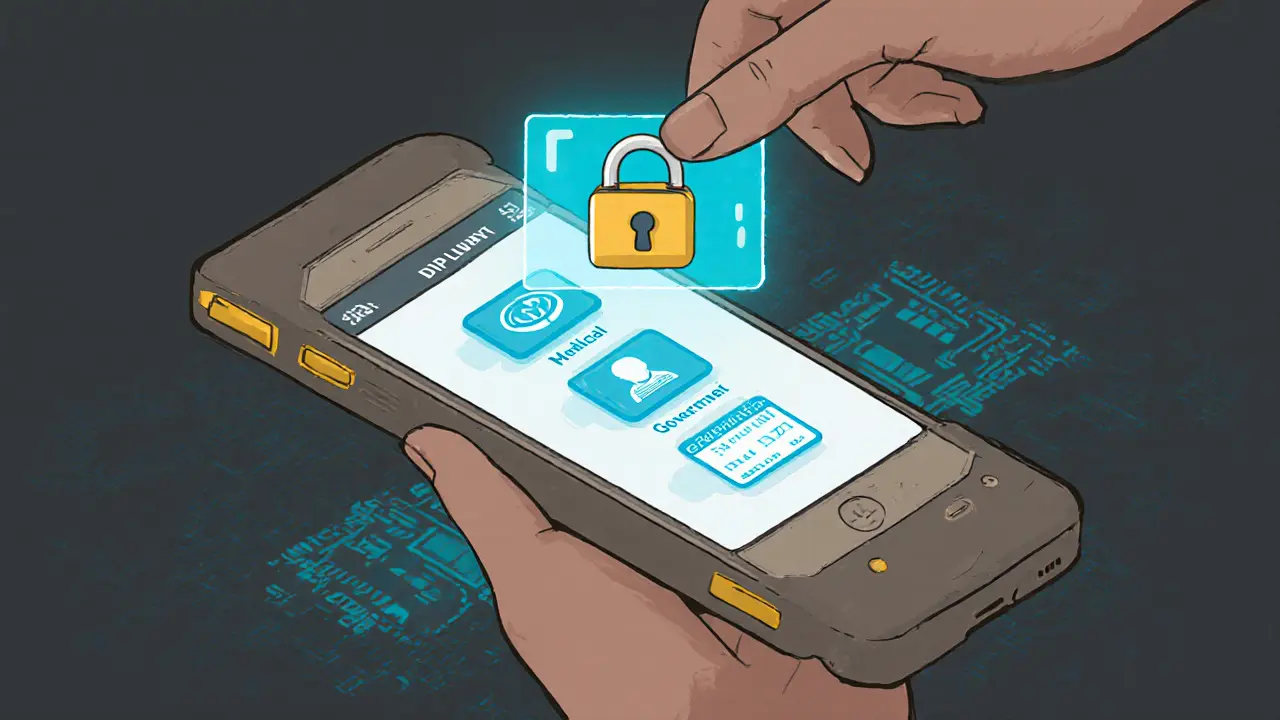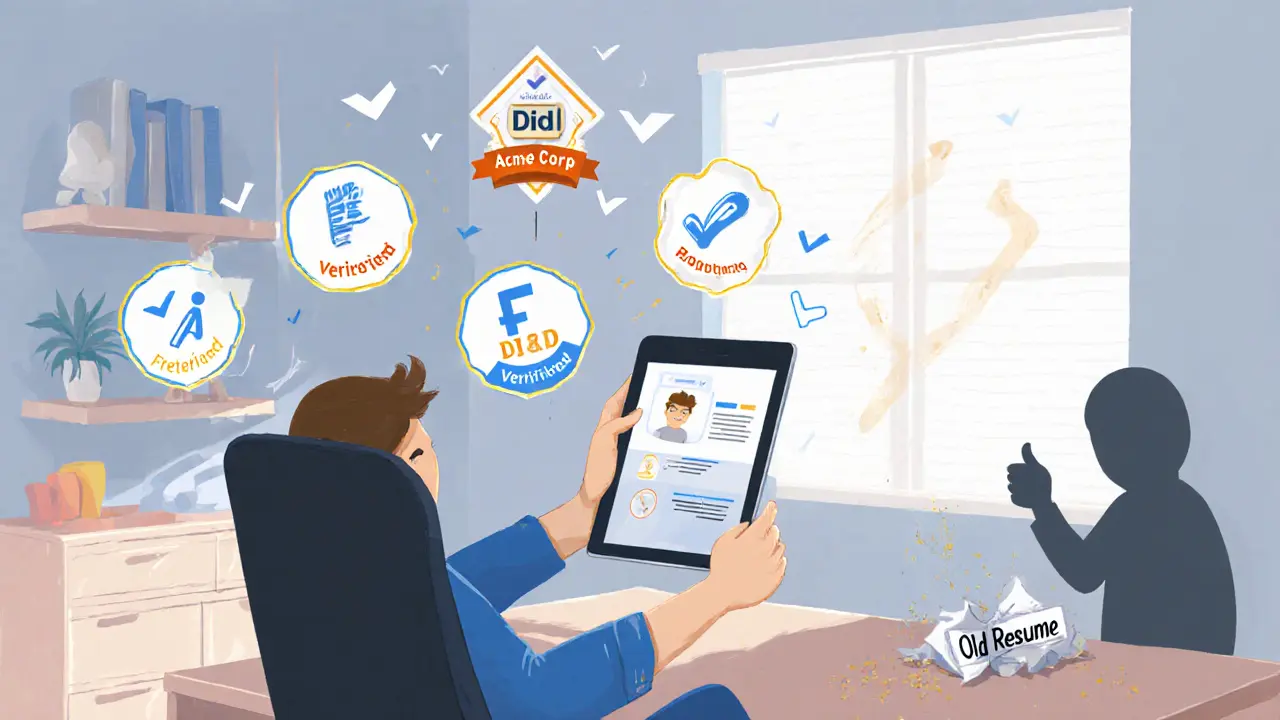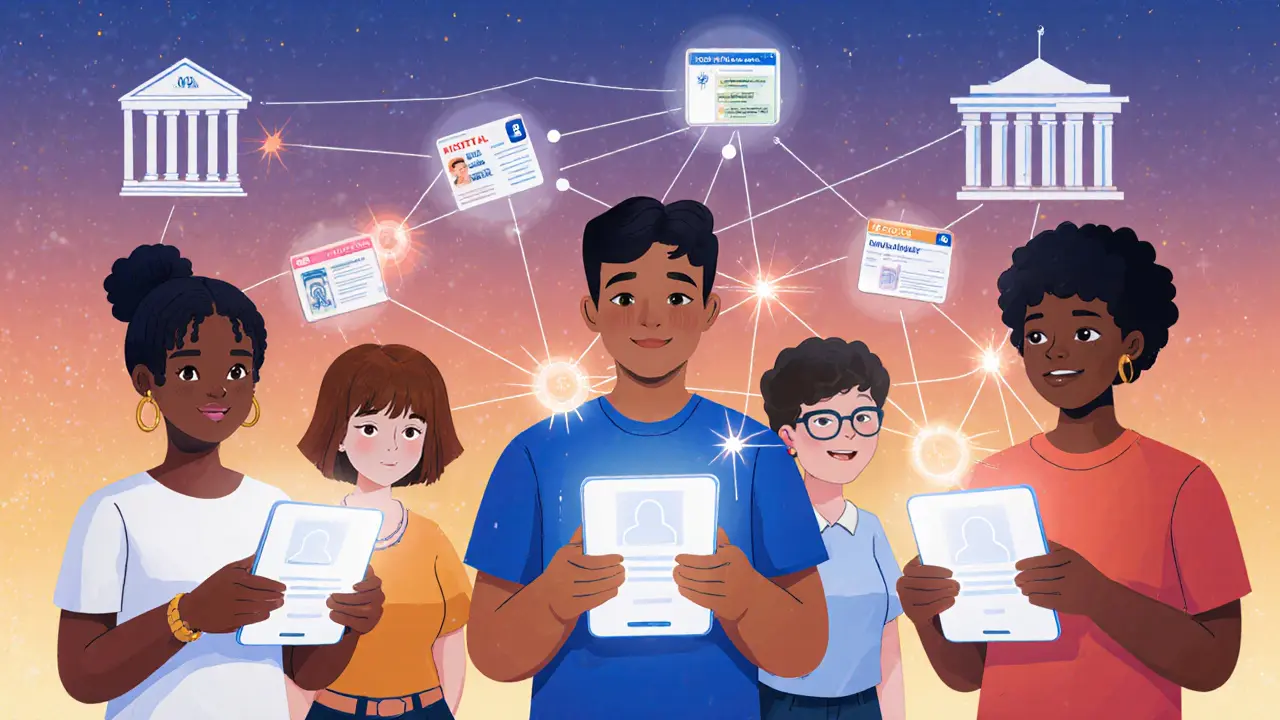DID Implementation Benefits Calculator
See how much time, money, and security you could save by switching from traditional identity systems to Decentralized Identity (DID).
Time Savings
Cost Savings
Security Improvements
Based on 2025 industry statistics: DID systems reduce verification time from 2-5 business days to under 2 minutes, cut costs by 97%, and have zero major breaches since 2020.
Ready to take control of your identity? Download a DID wallet like Microsoft Authenticator to get started.
Imagine logging into your bank, health portal, and government service without typing a single password. No reset links. No security questions. No third-party trackers. Just a quick tap on your phone - and you’re in. That’s not science fiction. It’s what DID - Decentralized Identifiers - makes possible today.
Traditional digital identities are broken. Your email, social media logins, and even your government ID are all tied to centralized systems that store your data in one place. That’s a magnet for hackers. In 2022 alone, over 1.2 billion records were exposed in data breaches. And it’s not getting better. The problem isn’t just theft - it’s control. You don’t own your identity. Companies do. And they sell it, leak it, or lock you out when they want to.
DID changes that. Built on open standards from the World Wide Web Consortium (W3C), a DID is your personal digital passport. It’s not stored on a server. It lives on a blockchain or distributed ledger - like Bitcoin, Ethereum, or Sovrin - and only you hold the keys. No middleman. No single point of failure. And you decide exactly what to share - and when.
How DID Works: The Three Pillars
DID isn’t just one thing. It’s a system built on three parts that work together:
- DID - a unique, cryptographically secure identifier like
did:ethr:0x123.... It’s not a username. It’s a public key tied to you, registered on a decentralized network. - Verifiable Credentials - digital versions of your driver’s license, diploma, or vaccine record. Issued by trusted entities (like a university or government), signed with cryptography so no one can fake them.
- Digital Identity Wallet - your app-based vault. Think of it like a digital wallet for your ID. Apps like Microsoft Authenticator, Trust Wallet, or Sovrin Wallet store your DIDs and credentials. You control what you show, when, and to whom.
Here’s how it plays out in real life: You get your university degree. Instead of an emailed PDF, the school issues a verifiable credential linked to your DID. Later, when applying for a job, you open your wallet, select the credential, and send only the proof that you graduated - not your full name, birthdate, or address. The employer verifies it instantly. No call to the registrar. No waiting days for confirmation.
Top Real-World DID Use Cases in 2025
1. Government Services: The EU’s EBSI Network
The European Union’s European Blockchain Services Infrastructure (EBSI) is the largest public-sector DID rollout in the world. As of May 2025, 27 member states are connected. Citizens use DIDs to access tax filings, healthcare records, and unemployment benefits - all across borders.
Before EBSI, a German citizen moving to Spain had to mail physical documents, wait weeks, and repeat the process for every service. Now, they verify their identity in under two minutes using a DID. The system handles 47,000 verifications daily. No central database. No duplicate records. Just encrypted, user-controlled proof.
And it’s mandatory now. With eIDAS 2.0 in effect since September 2024, all EU public digital services must support verifiable credentials. That’s not optional. It’s law.
2. Healthcare: Secure Medical Records Without the Risk
Hospital systems still rely on paper forms, faxed records, and siloed databases. Patient data is constantly at risk. In 2023, over 1,400 healthcare breaches were reported globally.
DID fixes this. Imagine your medical history - allergies, prescriptions, lab results - stored as verifiable credentials in your wallet. When you visit a new clinic, you share only what’s needed: your blood type, not your full diagnosis history. Your doctor verifies it instantly. No more filling out the same forms every visit. No more lost records.
HIMSS Analytics reports 19% of healthcare providers in the U.S. and EU have started piloting DID systems. Major players like Epic and Cerner are integrating DID support into their platforms. One pilot in New Zealand reduced patient onboarding time from 3 days to 12 minutes.
3. Financial Services: KYC That Doesn’t Make You a Data Point
Opening a bank account used to mean handing over your passport, utility bill, and selfie. The bank stored all of it. Then, you got phishing emails. Then, your identity was stolen.
With DIDs, you get one verifiable credential from your government - say, a digital ID. You show it to your bank. They verify it. Done. You never give them your full document. They don’t store it. You control the access.
Deloitte’s 2024 report found 28% of banks now use DID for KYC (Know Your Customer) checks. Mastercard’s Identity Check Mobile, used by 8.7 million people across 32 countries, lets you log into fintech apps with your DID instead of passwords. Fraud rates dropped 62% in the first year.
4. Education: Degrees That Can’t Be Faked
How many fake diplomas are out there? A 2023 study estimated over 1.2 million fraudulent degrees were sold online. Employers waste hours verifying credentials.
With DID, universities issue verifiable credentials directly to graduates. A degree from MIT? It’s cryptographically signed. Any employer can verify it in seconds - without contacting the school. No more calling registrars. No more waiting. And no more forged transcripts.
Over 150 universities, including Stanford, the University of London, and the University of Auckland, now issue DIDs for diplomas. In 2024, the State of Colorado launched its own DID-based driver’s license system. Over 150,000 residents now use it to prove identity at DMVs, airports, and even bars - all without showing a physical card.
5. Freelancers and Remote Work: Prove Your Skills, Not Your Resume
Freelancers spend hours building portfolios, collecting testimonials, and chasing references. Clients don’t trust them. Platforms take 20% cuts.
DID lets you collect verifiable credentials from clients: “Verified by Acme Corp - completed 100 hours of UI design.” “Certified by Figma - advanced prototyping.” Each is signed, tamper-proof, and stored in your wallet.
On platforms like Upwork or Toptal, you can now show your DID profile instead of a resume. Employers see real, verified proof - not claims. One freelancer in Berlin reported a 40% increase in job offers after switching to a DID-based profile. No more waiting for references. No more lying about experience.
Why DID Beats Traditional Identity
Here’s the stark contrast:
| Feature | DID (Decentralized) | Traditional (Centralized) |
|---|---|---|
| Data Storage | User’s wallet (encrypted) | Corporate or government server |
| Verification Time | Under 2 minutes | 2-5 business days |
| Security Breaches | Zero major breaches since 2020 | 327 breaches in 2023 |
| User Control | Full control - share only what you want | None - organizations own your data |
| Onboarding Speed | 67% success rate for 10,000+ users | 92% success rate |
| Verification Accuracy | 99.998% | 87.4% |
DID wins on security, speed, and privacy. But it’s not perfect. Onboarding 10,000 users at once? Traditional systems still handle it better. And if you lose your private key? Recovery is possible - through social recovery (trusting 3 friends to help you reset) - but it’s not as simple as clicking “Forgot Password.”

Who’s Adopting DID - and Who’s Not
Adoption is growing fast, but unevenly.
- Leading sectors: Financial services (28%), healthcare (19%), government (15%).
- Early adopters: EU member states, U.S. states like Colorado, MIT, Stanford, Mastercard, Microsoft.
- Slow to adopt: Small businesses, legacy IT departments, organizations with outdated software.
Only 12% of Fortune 500 companies use DID today. But Gartner predicts that by 2027, 40% will have integrated it into at least one process. Why? Because the cost of not doing it is rising. Regulatory pressure, user demand for privacy, and the sheer cost of breaches are forcing change.
Challenges Still Standing in the Way
DID isn’t magic. It’s new. And new things break.
- Interoperability: Only 65% of DID systems can talk to each other. A credential from Sovrin might not work with a Microsoft wallet. That’s improving - DID Resolution 1.0 (Feb 2024) and Universal Wallet Spec (April 2024) are fixing this.
- Complexity: Non-technical users need 35-40 hours of training to feel comfortable. That’s a lot. Apps are getting better, but the UX still feels clunky to many.
- Regulatory gray zones: GDPR says you have the “right to be forgotten.” But blockchains are immutable. How do you delete a DID? Solutions like off-chain storage and revocation lists are being tested.
- Legacy systems: Most companies still run on 20-year-old software. Connecting that to a DID system? It takes 12-16 weeks and a team of blockchain-savvy devs.

The Future: What’s Next for DID?
Here’s what’s coming in the next two years:
- Quantum-resistant DIDs: NIST is working on new cryptographic standards to protect DIDs from future quantum computers. Expected by 2026.
- AI + DID: JPMorgan Chase is testing AI that verifies identity through voice and facial patterns - linked to your DID. No photo ID needed.
- Biometric integration: Your fingerprint or iris scan could unlock your DID wallet - securely stored on-device, never uploaded.
- Web3 logins: Soon, every website will offer “Login with DID” instead of “Login with Google.” No more 10 different passwords.
The market is exploding. In 2023, the global DID market hit $1.84 billion. By 2028, it’s projected to hit $12.73 billion. Venture capital poured $1.2 billion into DID startups last year alone. Polygon ID, Spruce ID, and Microsoft’s ION project are leading the charge.
Is DID Right for You?
If you’re a:
- Consumer: Yes - if you’re tired of password resets, data leaks, and being tracked everywhere. Start with a wallet like Microsoft Authenticator and get a verifiable credential from your city or university.
- Business owner: Start small. Use DID for employee onboarding or customer KYC. You’ll cut costs, reduce fraud, and build trust.
- Developer: Learn Hyperledger Aries or Microsoft ION. The tools are open source. The demand is growing. The skills will be valuable.
You don’t need to understand blockchain to use DID. Just like you don’t need to know how Wi-Fi works to stream a video. But you do need to understand that your identity is yours - and you deserve to control it.
The old way of identity is crumbling. The new way is here. And it’s not about technology. It’s about power. Who owns your data? You should.
What is a DID and how is it different from a username?
A DID (Decentralized Identifier) is a cryptographically secure, blockchain-based identifier that you own and control. Unlike a username - which is assigned by a company like Google or Facebook - a DID is generated by you and stored on a decentralized network. No company can delete it, sell it, or lock you out. You prove who you are using cryptographic keys, not passwords.
Can I lose my DID and get it back?
Yes - but not like a password reset. If you lose your private key, you can use a “social recovery” system. You pre-choose 3 trusted contacts (like family or friends). If you’re locked out, they help you restore access. This avoids centralized recovery servers. It’s more secure, but requires planning ahead.
Are DIDs secure against hacking?
Yes - significantly more than traditional systems. Since DIDs have no central database, there’s no single target for hackers. There have been zero major breaches of DID systems since 2020. The only way to compromise a DID is to steal your private key - which is why using a secure wallet and enabling biometric locks is critical.
Do I need a blockchain wallet to use DID?
You need a digital identity wallet - not necessarily a crypto wallet. Apps like Microsoft Authenticator, Trust Wallet, or Sovrin Wallet are designed for DIDs. You don’t need to buy cryptocurrency. These wallets store your credentials and DIDs securely. Think of them as encrypted digital ID folders.
Is DID legal in my country?
Yes - in most developed countries. The EU mandates DID support under eIDAS 2.0. The U.S., Canada, Australia, and Japan are actively testing and adopting DID systems. Some countries are still developing regulations, but there’s no global ban. DIDs comply with GDPR and other privacy laws because they give you control over your data.
Can I use DID for everyday things like shopping?
Not yet everywhere - but it’s coming. Some online retailers now let you pay with DID-based identity verification instead of entering your card details. You prove you’re over 18 to buy alcohol, or that you’re a local resident for tax exemptions - without sharing your full name or address. Wider adoption depends on merchants integrating DID support, which is growing rapidly in 2025.
How do I get started with DID?
Start by downloading a DID wallet like Microsoft Authenticator or Trust Wallet. Then, look for a trusted issuer - your university, local government, or employer - that offers verifiable credentials. Once you have one, you can start using it to log in to services that support DID. Most platforms now have a “Login with DID” option. Try it on a non-critical site first.

dude i just want to log in without typing anything 😭 why is this so hard?? my phone already knows who i am... why do i gotta be a blockchain wizard?? 🤦♀️
This is just another tech fantasy that ignores real people. You lose your key you’re locked out forever. No one cares about your fancy crypto passport when you just need to reset your bank login
This is actually so exciting! I’ve been waiting for something like this for years. Imagine a grandmother in rural India accessing her pension without traveling 50km. This isn’t just tech-it’s dignity. Can’t wait to see more pilots in developing countries 🙌
Wait… so you’re telling me the government and big tech are now giving us ‘control’ over our identity? 😏 I’ve got news for you. This is just a slicker way to track us. Blockchain doesn’t erase data-it just hides it better. They’ll still know everything. Mark my words.
Why we even talking about this? India don’t need this. We have Aadhaar. Simple. Fast. Works. Why copy欧美 stuff? This DID thing is just for rich people with fancy phones
Honestly, the only reason this isn’t mainstream yet is because most people are too intellectually lazy to understand cryptographic key management. It’s not about tech-it’s about cognitive readiness. If you can’t grasp zero-knowledge proofs, you probably shouldn’t be allowed to vote either.
I tried Microsoft Authenticator with my university credential last week. It was actually smooth. No stress. No forms. Just tapped and done. Small win for privacy. Maybe this isn’t so far off after all.
The real issue is wallet UX. Most people think a DID is a crypto wallet and panic. You need to simplify the flow: 1) download app 2) scan gov ID 3) done. No keys. No mnemonics. No ‘social recovery’ nonsense. The tech works. The interface doesn't. Fix that first. Also typo: ‘verifiable’ is spelled wrong in the table. Just saying.
In Nigeria, we have been using mobile-based identity for years through NIN and BVN. But this DID model? It could revolutionize how we verify small business owners for microloans. Imagine a market woman in Lagos proving her tax compliance without a single paper document. This is not just innovation-it is liberation. Thank you for this thoughtful piece.
Control over identity? You mean like control over your own data? How quaint. The real power is in the algorithm that decides what you’re allowed to prove. This isn’t liberation-it’s curated autonomy.
I read the whole thing. 19% of healthcare providers? That’s not adoption, that’s a pilot. And ‘zero breaches since 2020’? Bro, DID systems aren’t even live at scale yet. You’re cherry-picking stats to sell a dream. This isn’t the future-it’s a VC-funded fantasy.
This is actually happening and it’s wild 😍 I used my DID to book a flight and check into my hotel last month. No ID scan. No passport. Just my phone. Felt like i was in a sci-fi movie. Also if you’re scared of losing your key just set up social recovery with your bestie 👯♀️🚀